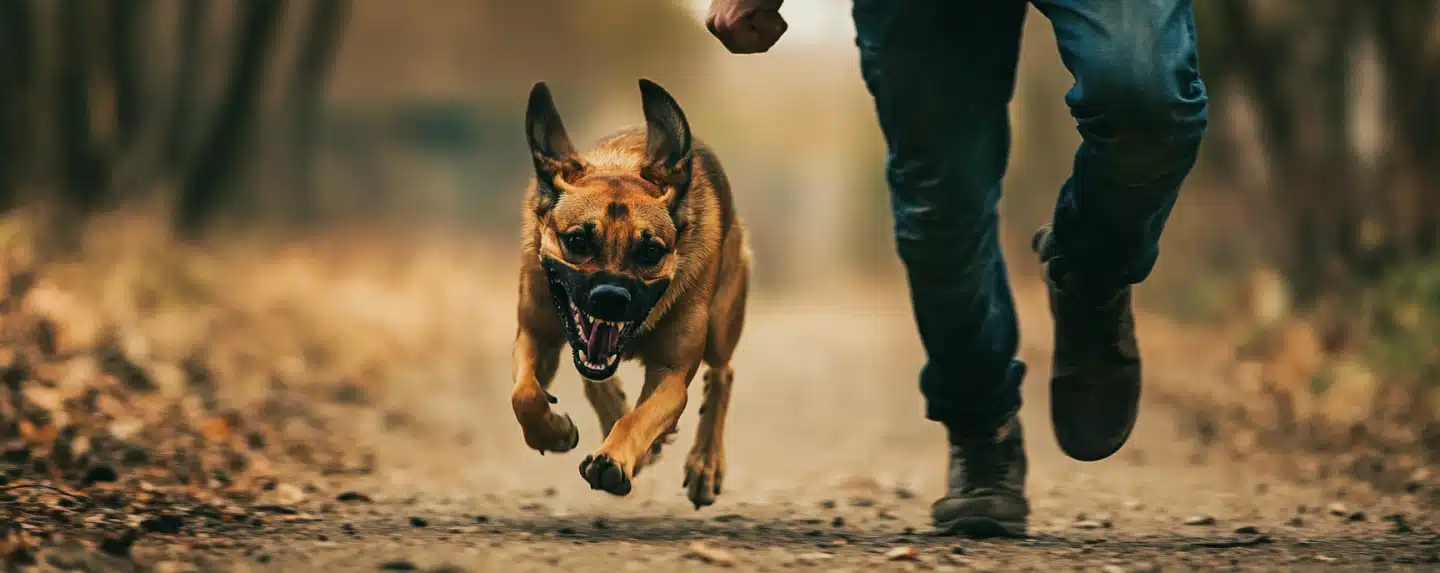Dog Bite Tendon Damage Symptoms: What to Look For and How to Act
Last updated Wednesday, September 18th, 2024

Dog bites can severely damage tendons, leading to dog bite tendon damage symptoms such as severe pain, swelling, limited mobility, and visible tendons. Recognizing these symptoms quickly is vital to prevent complications. This article will explore these symptoms and what actions to take.
Key Takeaways
- Recognizing symptoms of tendon damage from dog bites is crucial, including severe pain, swelling, limited mobility, and visible tendon exposure, which all require immediate medical attention.
- Signs of infection, such as increased redness, pus, fever, and systemic symptoms, are serious post-bite complications that necessitate prompt treatment to prevent severe health issues.
- Proper first aid and professional medical treatment are essential for recovery from tendon injuries due to dog bites, including wound cleaning, bleeding control, and potentially surgical intervention along with rehabilitation.
Recognizing Tendon Damage from Dog Bites
Dog bites can cause significant injuries, particularly to the tendons, leading to severe pain, limited mobility, and loss of function. Early recognition of symptoms can prevent long-term complications and ensure proper treatment. Immediate medical evaluation is necessary as tendon damage can result in long-term disability, infections, and persistent pain.
Severe injuries can result from most dog bites if not addressed promptly. The severity of the injury can be influenced by factors such as the location of the bite and the age of the victim. Understanding the signs of tendon damage helps in seeking timely medical attention and avoiding further complications.
Severe Pain and Swelling
Severe pain and swelling around the bite area are common indicators of significant tendon damage. Persistent severe pain and swelling after a dog bite require immediate medical attention. Appropriate treatment at an early stage can minimize potential problems and promote proper healing.
The severity of tendon damage can be influenced by the bite’s location and the victim’s age. Pain and swelling may sometimes be accompanied by limited movement, indicating a potential long-term disability. Addressing these symptoms with immediate medical evaluation can prevent serious complications.
Limited Mobility and Stiffness
Loss of movement in fingers or wrists following a dog bite could indicate tendon injury. Recognizing these signs ensures proper treatment and helps prevent long-term damage.
Limited mobility or stiffness in the affected area requires prompt medical attention to avoid further complications.
Visible Tendon Exposure
Visible tendons through the wound signify a severe injury requiring immediate medical attention. These complex injuries demand urgent care to prevent further damage and ensure proper healing.
Seek medical help immediately if there is visible tendon exposure.
Infection Risks with Tendon Injuries
Before:
Dog bites introduce bacteria from the animal’s mouth into the wound, posing a high risk of infection. Common signs of infection after a dog bite include fever, increased redness, and pain. Additionally, one may experience difficulty moving, drainage, swelling, and red streaks. Immediate medical attention is essential as untreated dog bites can lead to serious infections.
After:
Common signs of infection after a dog bite include:
- Fever
- Increased redness
- Pain
- Difficulty moving
- Drainage
- Swelling
- Red streaks
Immediate medical attention is essential as untreated dog bites can lead to serious infections.
Thoroughly cleaning the bite area with soap and water, applying antibiotic cream, and covering it with a bandage can help prevent infection. Recognizing infection signs and acting quickly can significantly reduce the risk of serious complications.
Redness and Warmth
Swelling, redness, and warmth around a dog bite can indicate a potential infection. Persistent pain at the bite site beyond a day warrants medical attention as it may be a warning sign of infection. Red streaks extending from the wound suggest lymphangitis, a serious condition that requires urgent care.
Infection risks increase if the bite wound is contaminated with bacteria from the dog’s mouth. Infection symptoms may include swelling around the wound along with warmth and redness. Increased pain and warmth in a bite wound are signs that infection might have occurred.
Pus and Discharge
Pus or unusual discharge from a dog bite wound indicates a serious infection. Infections can complicate tendon healing and lead to long-term complications if untreated.
Prompt medical attention is necessary if pus or unusual discharge is observed.
Fever and Systemic Symptoms
Fever or systemic symptoms like chills indicate a spreading infection that requires urgent medical attention. Pus from a dog bite wound clearly indicates a serious infection that could impede tendon recovery.
Systemic symptoms or signs of infection after a dog bite require immediate medical intervention.
Immediate First Aid for Dog Bite Tendon Injuries
Initial first aid steps include cleaning the wound, applying pressure to stop bleeding, and bandaging the area. If the skin has been broken, it is crucial to seek medical attention to address potential complications. Proper first aid significantly impacts recovery outcomes for tendon injuries from dog bites.
Severe injuries from dog bites require immediate attention. Thoroughly cleaning the wound and promptly addressing bleeding are essential steps. Immobilizing the affected area prevents further damage and aids recovery.
These actions significantly impact the overall healing process.
Cleaning the Wound
Thoroughly wash the dog bite wound with soap and water. Do this for 3 to 5 minutes to ensure it is effectively cleaned. An antiseptic solution like chlorhexidine or povidone-iodine after washing can further prevent infections in dog bite wounds.
Proper wound cleaning is crucial to reduce infection risk. Disinfecting the wound with antiseptic solutions can significantly lower complication risks and promote healing. It is also important to wash the wound properly.
Controlling Bleeding
Applying consistent pressure with a clean cloth for 5-10 minutes effectively stops bleeding from a dog bite. Controlling bleeding is crucial to prevent excessive blood loss and complications from dog bite injuries.
Elevating the injured hand reduces blood flow to the area and minimizes swelling.
Immobilizing the Hand
A splint restricts movement and protects the injured area from further damage. Immobilizing the hand after a tendon injury prevents further damage and aids healing.
Keep the injured hand immobilized until professional medical help is available for proper treatment.
Professional Medical Treatment for Tendon Damage
Seeking professional medical care for dog bite-related tendon injuries is necessary. This helps prevent infections and complications. Recovery prognosis from animal bite injuries is generally positive. This holds true particularly when proper medical care is provided. Hand surgery is required promptly in cases of infection of a flexor tendon sheath or joint.
Surgical procedures for severe dog bite injuries may include washout, decontamination, and debridement. Reconstructive surgery might also be necessary. Factors like wound depth, size, location, and the presence of infection or dead tissue determine the need for surgical intervention.
Recovery after surgery for severe dog bite hand injuries can range from a week to several months.
Surgical Repair
Tendon injuries from dog bites often require surgical intervention to restore function and prevent long-term complications. Surgical repair is essential for torn or severed tendons to ensure proper alignment, healing, and a return to normal function.
Pain management, anti-inflammatory, and complication-prevention medications may be required alongside surgical treatment. Inpatient antibiotic treatment may be necessary if there are underlying fractures associated with the tendon injury. A comprehensive treatment plan including surgical repair and follow-up medications is essential for effective tendon injury recovery.
Antibiotics and Medications
Managing infection after dog bites usually involves antibiotics along with pain and anti-inflammatory medications. Antibiotics are prescribed to treat or prevent dog bite infection following dog bites.
Pain management medications might be necessary to alleviate discomfort from tendon damage caused by dog bites. Antibiotics and pain management are essential components of effective treatment to ensure healing and recovery after a dog bite.
Physical Therapy
Post-surgery rehabilitation typically includes physical therapy to regain strength and mobility after tendon damage. Physical therapy is often prescribed during tendon injury recovery.
Preventing Dog Bites and Related Injuries
Preventing dog bites helps avoid severe complications arising from such injuries. Educating people, especially children, about dog safety can significantly reduce bite risks. Children aged 5 to 9 are particularly vulnerable to dog attacks, so teaching them safe behaviors around dogs is essential.
Knowledge about injury types and prevention tips helps prevent dog bites. Recognizing aggressive dog behavior and taking appropriate actions can help prevent potential attacks.
Reporting dog bites helps prevent future incidents and promotes community safety.
Educating Children on Dog Safety
Teaching dog safety to children should start as early as 18 months to instill proper behavior around dogs. Children’s lack of understanding of potential danger makes them more likely to approach dogs fearlessly. Teaching children to recognize aggressive dog behavior can significantly lower bite risks.
Children should learn to avoid approaching strange dogs and always ask for permission before petting. Early education instills a lifelong understanding of safe interactions with dogs and helps prevent animal bites.
Recognizing Aggressive Behavior in Dogs
Recognizing and understanding signs of aggression in dogs can prevent potential attacks. Yawning, lip licking, and a tucked tail are signs of a dog’s fear or stress. Awareness of these signs allows individuals to take action to avoid encounters that may lead to dog bites.
Reporting Dog Bites
Reporting dog bites helps prevent future incidents and promotes community safety. Reporting dog bite incidents helps in understanding patterns and preventing future occurrences. Reporting bite incidents to local animal control authorities ensures proper measures are taken.
Frequently Asked Questions
What are the first signs of tendon damage from a dog bite?
The first signs of tendon damage from a dog bite include severe pain, swelling, limited mobility in the fingers or wrist, and visible tendon exposure. It is essential to seek immediate medical attention to prevent further complications.
How can I prevent infections after a dog bite?
To effectively prevent infections after a dog bite, clean the wound with soap and water for 3 to 5 minutes, apply antiseptic, and cover it with a clean bandage. Additionally, seek medical attention for possible antibiotic treatment.
What should I do if there is pus or unusual discharge from the bite wound?
If there is pus or unusual discharge from a bite wound, urgently seek medical attention to address the potential infection and avoid complications. Your health should be the priority.
Why is physical therapy important after tendon damage from a dog bite?
Physical therapy is essential after tendon damage from a dog bite because it aids in regaining strength and mobility, leading to a more effective recovery. Without it, you risk prolonged limitations in function.
How can I educate my children about dog safety?
To effectively educate your children about dog safety, begin as early as 18 months by teaching them to recognize aggressive behavior and emphasizing the importance of asking for permission before approaching a dog. This knowledge can significantly reduce the risk of dog bites.












